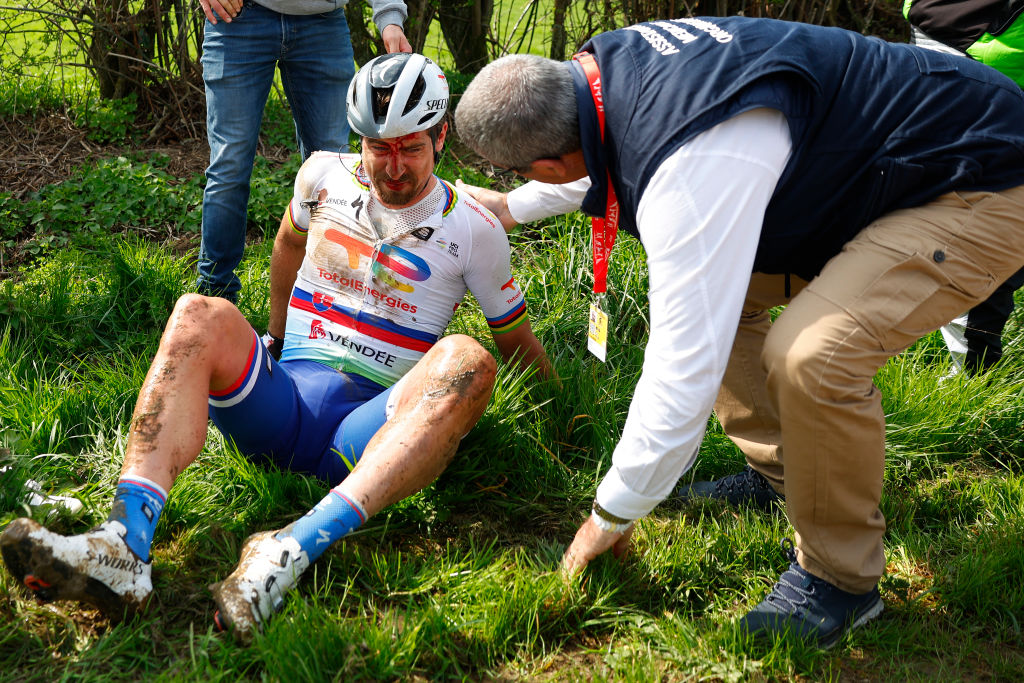What is the concussion protocol for cycling?
Signs and symptoms checked quickly before riders can return to racing in process set down by UCI

Concussions are a significant portion of athlete injuries in professional cycling but diagnosing them in a sport where there are no time-outs requires a rapid assessment.
Even with improvements in helmet technology such as MiPS, even the best helmets aren't always effective at preventing concussions.
Recently, Tom Pidcock's end-of-season ambitions were hit by a concussion suffered in the Tour of Britain. Recovery from a brain injury can be mentally and physically exhausting - 2023 US road champion Quinn Simmons said he "fell apart pretty bad" while trying to recover from one.
However, all is not lost after a top athlete suffers a concussion. Olympic medalist Haley Batten described her concussion recovery as transformative.
Pro riders have had much better care and caution when it comes to concussions since the UCI approved a specific protocol for checking riders who have crashed for signs and symptoms of a concussion in 2020. The protocol is based on the SCAT5 standardized tool for evaluating concussions but modified for cyclists.
Before the protocol was adopted there were several high-profile incidents where riders continued racing with concussions. Romain Bardet rode for 90 kilometres while concussed at the 2019 Tour de France.
Earlier incidents such as a crash from Toms Skujins in the Tour of California, and Chris Horner and Tom Boonen during the 2011 Tour de France led individual teams to adopt their own concussion protocols until the UCI agreed upon an official guidance.
The latest race content, interviews, features, reviews and expert buying guides, direct to your inbox!
The protocol has three stages: first, the initial assessment immediately after a crash, then a post-race follow-up and another on the day following the injury.
During a rapid screen, a rider is asked if they have a headache, nausea, dizziness or double vision - two or more mild symptoms or one moderate to severe indicate a possible concussion.
A rider may then be asked a series of questions to test their memory:
- What day is it?
- What race are we in?
- How many km to go?
- What was your last race?
- Who is the DS in this race?
- Who won yesterday (stage races)
Correct answers to all of the questions indicate a low probability of concussion and the rider would likely be allowed to continue. However, since racers may get questions wrong and not have a concussion, other tests are performed: checking for a pain-free range of motion of the neck and spine.
Another memory test where ten words are read off to the rider and they have to repeat as many as they can, three times. A score of 20-30 (1 point for each correct word) gives the rider a green light in the absence of other red flags.
The rider may be subjected to a balance test and delayed recall of the previously read words. Any stumbles or inability to recall more than four words raises suspicion of a concussion.
Read the full UCI Concussion Protocol.
A rider should be immediately withdrawn from competition if they display any of the following symptoms after a crash:
- Loss of consciousness, confirmed or suspected
- Seizure or convulsion
- Behaviour change, increasingly restlessness, agitation, combativeness
- Vomiting
- Severe or increasing headache
- Double vision
- Weakness or tingling / burning in arms or legs
- Neck pain or tenderness
- Lying motionless on the road or the track
- Disorientation, confusion, inability to respond to questions
- Balance impairment
- Blank or vacant look
- Facial injury after head trauma
- Blurred vision, diplopia, difficulty with tracking a moving target
- Inability to speak or swallow
Steps of the UCI concussion protocol
- Modified Maddocks questions ('What day is it?', etc.)
- Rapid symptom screen (headache, nausea, dizziness)
- Immediate 10 words recall
- Reverse digits
- Balance assessment (feet together, head back)
- Assessment of spine and neck
- Delayed 10 words recall
Sports-related concussion (SRC) protocol decision tree


Laura Weislo has been with Cyclingnews since 2006 after making a switch from a career in science. As Managing Editor, she coordinates coverage for North American events and global news. As former elite-level road racer who dabbled in cyclo-cross and track, Laura has a passion for all three disciplines. When not working she likes to go camping and explore lesser traveled roads, paths and gravel tracks. Laura specialises in covering doping, anti-doping, UCI governance and performing data analysis.
